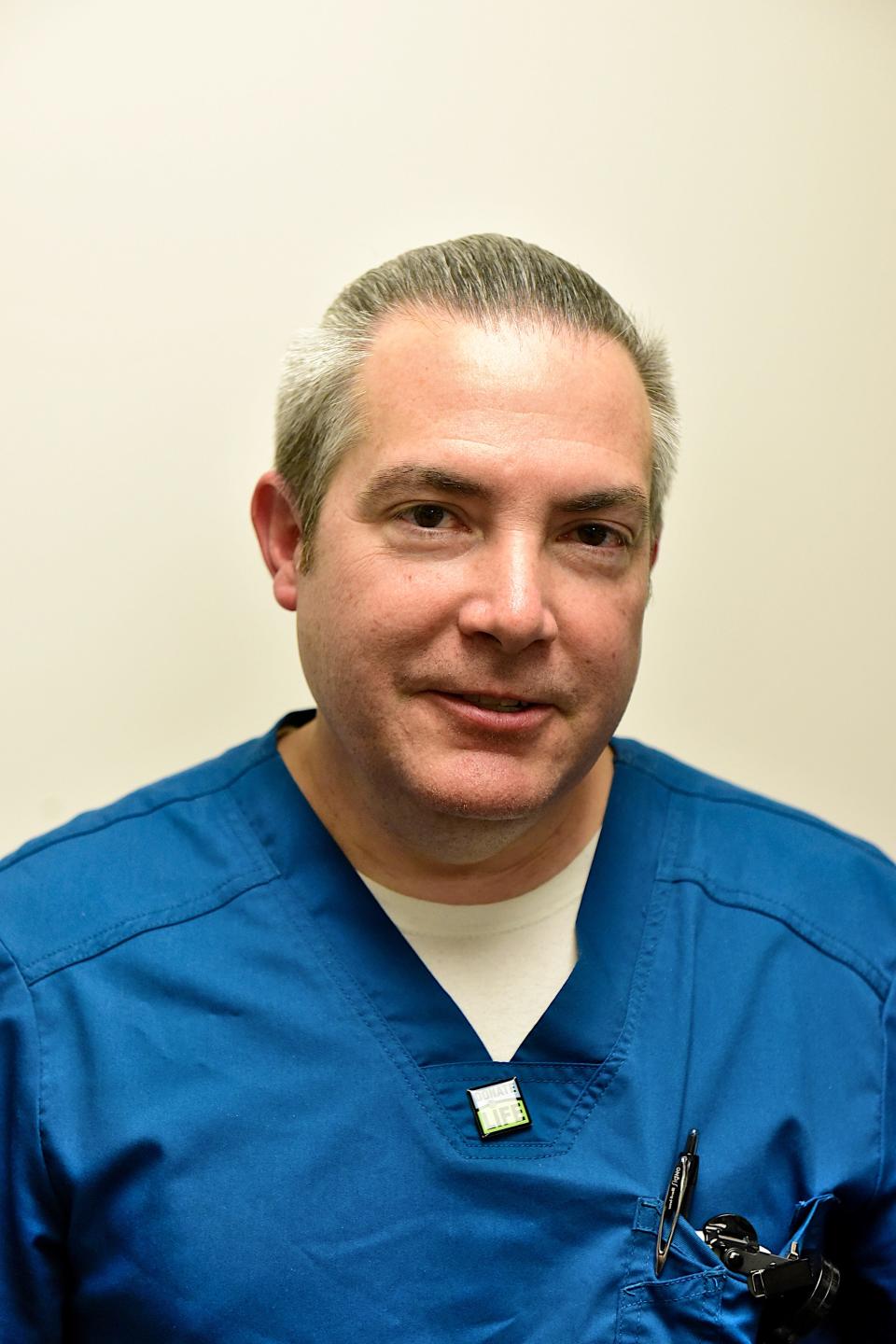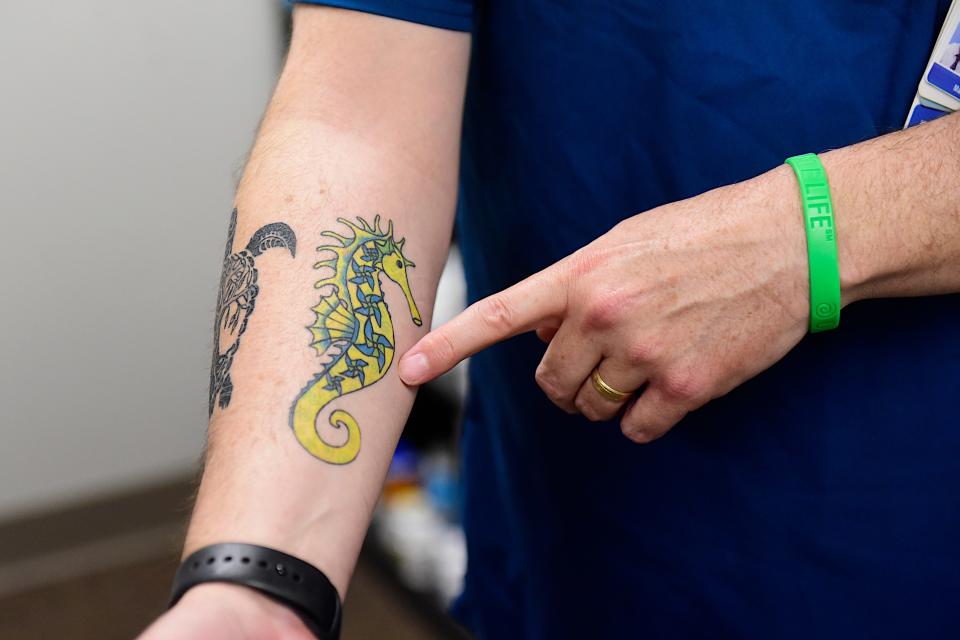'I wonder why I waited': Pharmacist still seizure free three years after laser ablation
- Oops!Something went wrong.Please try again later.
Planning ahead for his next seizure was Brian George's daily schedule − even at work − for more than 20 years.
"You adapt," he said. "You're always thinking, 'What if I have one?' You’re in a new environment, it’s like ‘OK, where's the exit? Where's the bathroom? How can I get out of here if I have one?’ I used to always hate getting on an airplane."
Thanks to a laser ablation procedure through OhioHealth, the pharmacist at Mansfield Hospital has been seizure free for three years.
"It definitely changed my life," George said. "I don't have to worry about a lot of the things I used to."
'I really didn't know where I was'
Not far down the hall from his hospital pharmacy is the room where George was born.
He grew up a half-dozen miles south, in Lexington.
During high school, George got a letter from The Ohio State University that recruited him to be a pharmacist. Seven years later, he became a Doctor of Pharmacy.
"I graduated June of 1998 and started here July 1 of 1998," George said. "I did that for 20-plus years and I took the director's job."

He married his sweetheart, Heather, along the way. They had two sons, Gavin and Dylan.
His would have been a storybook life, had it not been for the seizures.
"I had my first seizure, I was probably like 8 or 9 months old," George said. "High fever, all seizures."
The seizures went away while he was a toddler, then returned during his teenage years.
"I really didn't get diagnosed completely until my second year of college," George said.
He learned he had partial epilepsy, which affected only one area of his brain − more severe forms of epilepsy attack most of the brain all at once.
Because he was only partially epileptic, George's seizures generally were mild. He would become nauseated during onset, and knew to get somewhere private with a trashcan or a toilet in case he needed to throw up.
"The last conscious thought I'd have was 'You're going to be sick,'" George said. "Then, 30 seconds, 45 seconds later, I'd come out of it and I'd be fine."
They weren't always that simple, though.
"One time in college, I got turned around and I ended up on some other floor in the building," George said. "When I came out of it, I really didn't know where I was."
'You're kind of just on autopilot'
That was George's routine for parts of three decades.
"I kind of made sure that the people I worked with closely knew in case something happened," George said.
Since he was employed in a hospital, he didn't want anyone to get the wrong idea and call for medical support during one of his seizures.
"Wait until I come out of it," George would tell coworkers. "This is what it looks like. This is what will happen."

The threat of a seizure was on his mind daily, but they only happened about once every few weeks.
After he did have a seizure, he would clean up and get back to work.
"You're kind of just on autopilot, if you will," George said. "Once you come out of it, it's fine."
'It was just getting worse'
The frequency of his seizures increased as time passed. Doctor friends told him there was a procedure that might help, but the thought of surgery made him nervous.
"I was like, it doesn't impact me enough to want somebody to, you know, get in my brain," George said. "It was scary. It took me a while to come around to even think about having it done."
He decided to keep track of his seizures and realized his average had grown to two per week.
"No meds were helping," George said. "It was just getting worse."
He learned the surgery he would need was called laser interstitial thermal therapy, or, more commonly, laser ablation. The procedure has been used about 15 years.
Laser ablations can only treat partial epilepsy caused by a small portion of the brain, according to Emily Klatte, MD, board certified adult neurologist with the OhioHealth Physician Group.
'We decided to go ahead and get me scheduled'
George finally decided to visit the epilepsy monitoring unit at OhioHealth Riverside Methodist Hospital in Columbus for an electroencephalogram, known as an EEG.
He stayed there all weekend, wires and cameras monitoring his brain activity for three days to see if he might be a good candidate for the surgery.
"We stop seizure medications and try to make people have their seizures so we can figure out where they start," Klatte explained.
George had three seizures that weekend. They all originated in his right temporal lobe, in an area called the hippocampus.
Doctors also discovered his motor skills, language and memory were all stored in the left side of his brain, which meant there was little risk in making a correction on the right side of his brain.
The medical staff cleared George for the operation.

Despite the news, he still wasn't sold on the procedure.
"It took another month or so, maybe a couple of months," George said.
He and his wife met with the neurologist and the neurosurgeon to learn more.
"I said, 'I'm a little scared, what happens if I don't have the surgery?' They said it would continue to get worse," George said. "It would impact my memory, things like that. We decided to go ahead and get me scheduled."
'We hope that they remain seizure free indefinitely'
Laser ablations are now considered minimally invasive, but they are still a form of brain surgery.
"The surgeon will drill a small hole in the skull," Klatte said.
Doctors guide a laser catheter through the skull, then do extensive imaging to ensure the device is in the best possible location.
"They deliver heat and it kind of destroys that part of the brain tissue," Klatte said.
In a matter of moments, the surgeon eliminated the tiny portion of George's brain that was causing his seizures.
"We hope that they remain seizure free indefinitely," Klatte said. "Many times that is the case."
Despite having a portion of his brain operated on, George had only a limited recovery.
"They put a few staples in my head and closed it up," he said. "I spent the night one night and then I was home."
'I wonder why I waited so long'
George had his laser ablation in 2020, right before elective surgeries were canceled during the pandemic.
A year later, Heather needed her own surgery: an organ transplant. Fortunately, her operation went as well his.
They're both now fully recovered. After more than three years, the seizures are still gone.
"Looking back, I wonder why I waited so long," George said. "Obviously after the fact it's easier."
The seizures may be gone from his brain, but they'll always remain on his mind.
"You never want to jinx it or anything," George said. "It's not something I have to worry a whole awful lot about anymore, but I still take one medication at a very low dose just because."
He recommends anyone living with seizures talk to their doctor about the possibility of having a laser ablation.
And he admits the idea of surgery can be concerning for patients. It was for him, even after working in the hospital for nearly three decades.
"I can't imagine if I wasn't in healthcare trying to navigate some of the things that we've had to get through," George said. "I'm just very fortunate that I've had the experiences that I have. We've been very fortunate."
ztuggle@gannett.com
419-564-3508
This article originally appeared on Mansfield News Journal: Epileptic seizures still gone three years after man has laser ablation

